Welcome to StrawPoll’s enchanting realm of blossoming beauties! In this article, I will guide you through a mesmerizing journey exploring the world’s most beautiful fruit trees. These stunning, visually appealing, and attractive trees are guaranteed to add a touch of natural beauty to any landscape. Prepare to be captivated by their gorgeous blooms and picturesque charm.
Key Takeaways:
- Discover the most stunning fruit trees that can transform your garden into a visual paradise.
- Explore the unique characteristics and enchanting features of each tree.
- From the delicate elegance of the Cherry Blossom to the lush beauty of the Magnolia, these trees offer a feast for the eyes.
- Learn about the cultural significance and ornamental value of these captivating fruit trees.
- Immerse yourself in a world of blooming aesthetics and vibrant colors, celebrating the natural wonders of our planet.
Cherry Blossom Tree – Prunus serrulata
The Cherry Blossom Tree, scientifically known as Prunus serrulata, is the most popular and widely recognized blossoming tree in the world. Native to Japan, it is a symbol of the country’s culture and history. The tree is celebrated for its delicate pink and white flowers that bloom in the spring, creating a stunning visual display.
When in full bloom, the Cherry Blossom Tree transforms landscapes into breathtaking scenes, with its delicate petals gently falling like confetti. The ethereal beauty of these blossoms captivates the hearts of both locals and visitors alike, making the tree a cherished sight during Japan’s national Cherry Blossom Festival.
Standing at a height of 20-30 feet and spreading 15-25 feet wide, the Cherry Blossom Tree’s graceful form and mesmerizing flowers add a touch of elegance to any garden or park. The unique charm of these trees lies not only in their astounding beauty but also in their symbolic meaning.
The Cherry Blossom Tree holds significant cultural and symbolic importance in Japan, where it represents the transient and delicate nature of life. The fleeting blooming period reminds us to embrace the present moment and appreciate the beauty that surrounds us.
The allure of the Cherry Blossom Tree extends far beyond its native land. Its delicate pink and white flowers have become iconic symbols of beauty and grace worldwide. Whether painted onto traditional Japanese artwork or adorning the gardens of other countries, these blossoms continue to captivate and inspire.
Dogwood Tree – Cornus florida
The Dogwood Tree, scientifically known as Cornus florida, is a popular ornamental tree native to the eastern United States. It is admired for its showy flowers, which come in shades of pink and white, and its beautiful red foliage in the fall. The tree’s attractive bark adds to its visual appeal. It is a small-sized tree, reaching an average height of 15-30 feet. The Dogwood Tree is a favorite choice for landscaping due to its stunning blossoms and unique aesthetic features.
Features of the Dogwood Tree:
- Showy flowers in shades of pink and white
- Attractive bark
- Beautiful red foliage in the fall
- Small-sized tree, reaching an average height of 15-30 feet
With its vibrant flowers and striking bark, the Dogwood Tree is a standout choice for any garden or landscape. Its showy blossoms add a splash of color, while its unique bark provides year-round visual interest. Whether used as a focal point or as part of a larger planting scheme, the Dogwood Tree is sure to leave a lasting impression.
The Dogwood Tree is a favorite choice for landscaping due to its stunning blooms and unique aesthetic features.
So, if you’re looking for an ornamental tree that combines showy flowers, attractive bark, and beautiful foliage, the Dogwood Tree (Cornus florida) is an excellent choice. Its visual appeal will add charm and elegance to any outdoor space.
Magnolia Tree – Magnolia grandiflora
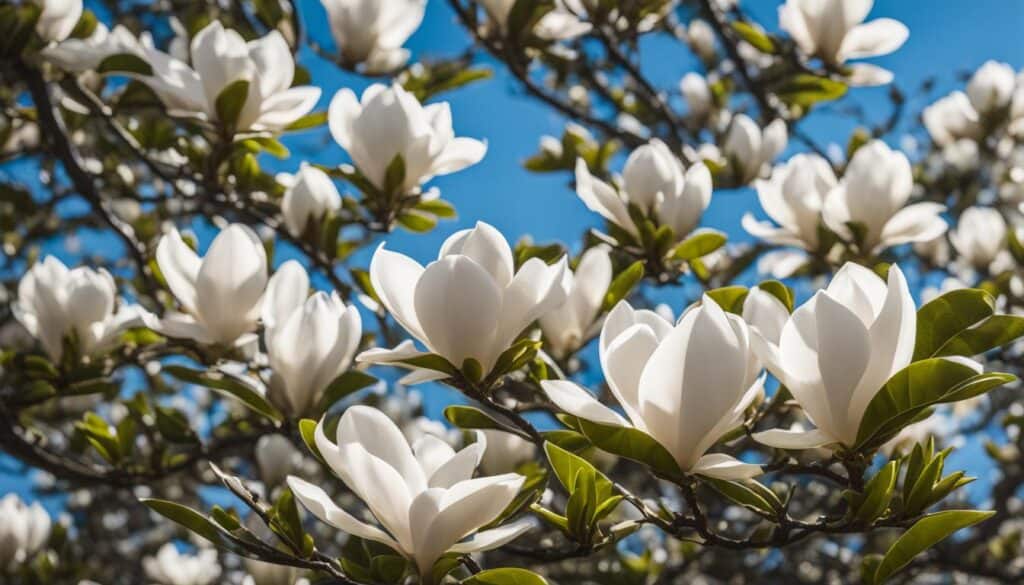
The Magnolia Tree, scientifically known as Magnolia grandiflora, is a magnificent evergreen tree renowned for its large, fragrant flowers and glossy leaves. Native to the southeastern United States, this majestic tree is a popular choice for landscaping due to its undeniable beauty and ease of care.
The Magnolia Tree produces stunning flowers in shades of white, pink, and purple, which bloom in the spring and summer, creating a breathtaking spectacle that captivates the senses. The size and beauty of these flowers make them a focal point in any garden or landscape.
What makes the Magnolia Tree truly remarkable is its glossy evergreen leaves. These leaves retain their vibrancy and shine throughout the year, adding a touch of elegance and sophistication to any outdoor space.
The Magnolia Tree is truly a sight to behold, with its towering height, large fragrant flowers, and glossy evergreen leaves. It stands as a testament to the wonders of nature and has the power to captivate anyone who sets eyes upon it.
Reaching heights of up to 90 feet, the Magnolia Tree commands attention and becomes a true centerpiece in any landscape. Its grandeur and presence create a sense of awe and wonder, making it a favorite among gardeners and nature enthusiasts.
“No flower says elegance quite like the Magnolia. Its large and fragrant blossoms, coupled with its glossy evergreen leaves, make it a showstopper in any garden.” – Garden Enthusiast
Apple Blossom Tree – Malus pumila
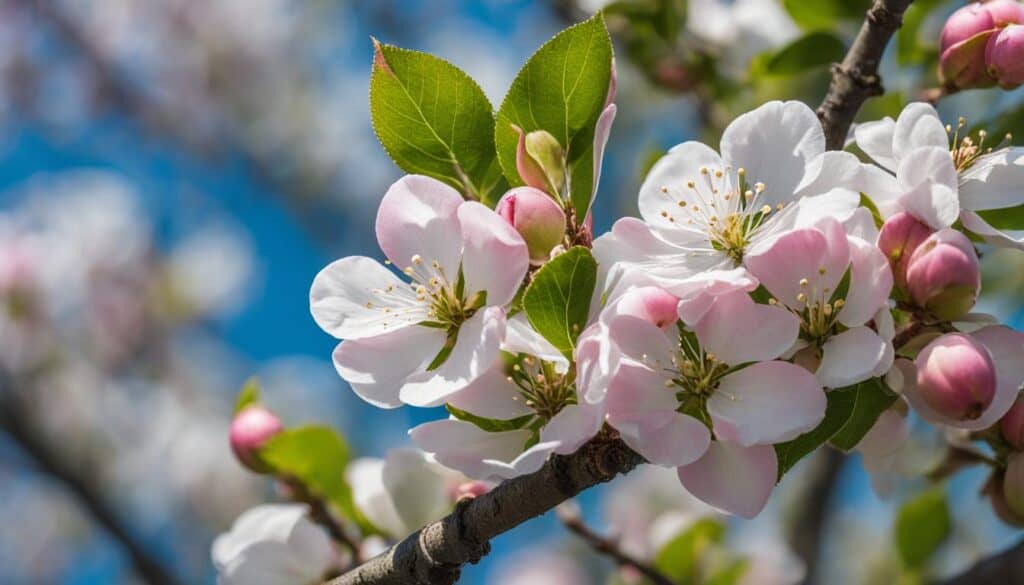
The Apple Blossom Tree, scientifically known as Malus pumila, is a stunning flowering tree that is loved for its delicate, fragrant blossoms. These flowers are not only visually appealing but also have culinary applications.
The Apple Blossom Tree typically reaches a height of 15-25 feet and has a rounded crown. Its flowers appear in early spring, covering the tree with clusters of small, five-petaled blossoms in white or pale pink. The fragrance of these blossoms fills the air, creating a delightful sensory experience in the garden.
Aside from its beauty, the Apple Blossom Tree also bears fruit that is used in a variety of culinary delights. The apples it produces are known for their crisp texture and sweet or tart flavor, making them a versatile ingredient in both sweet and savory recipes. From apple pies and tarts to apple sauce and cider, the fruit of the Apple Blossom Tree adds a delightful taste to a wide range of culinary creations.
The Apple Blossom Tree is not only a feast for the eyes but also a treat for the taste buds, making it a favorite among gardeners and cooks alike. Its fragrant flowers and culinary applications make it a versatile and cherished addition to any garden.
Peach Blossom Tree – Prunus persica

The Peach Blossom Tree, scientifically known as Prunus persica, is a captivating deciduous tree celebrated for its abundance of stunning blooms. Originating from China, this flowering tree has become synonymous with the arrival of spring and is cherished worldwide for its breathtaking beauty. With an average height of up to 25 feet, the Peach Blossom Tree showcases an array of delicate pink blooms that create a captivating spectacle. Its scientific name, Prunus persica, is derived from its fruit, the peach, which is enjoyed by many.
I am always in awe of the Peach Blossom Tree’s striking beauty. The delicate pink blooms create a mesmerizing sight that marks the arrival of spring. It’s like nature’s own celebration, filling the air with a sweet and enchanting aroma. The Peach Blossom Tree truly captures the essence of beauty and grace.
Crabapple Tree – Malus floribunda
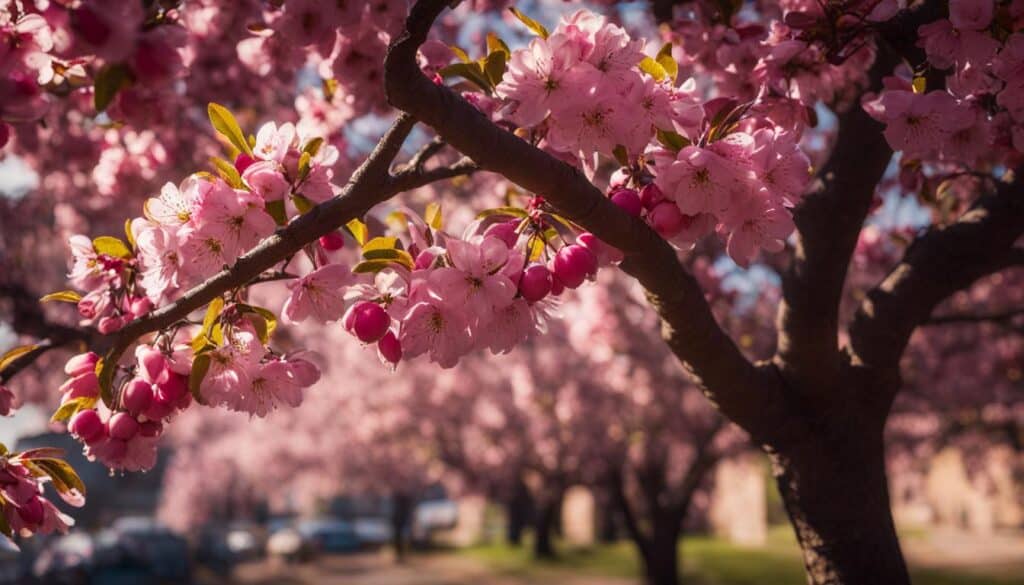
The Crabapple Tree, scientifically known as Malus floribunda, is a stunning flowering tree that belongs to the Rosaceae family. It is known for its abundant, vibrant blossoms that create a captivating display in the springtime. The tree features a dense, rounded canopy with dark green leaves that turn yellow in the fall. Its small, round fruits are often red or yellow and are a delight for birds and wildlife. The Crabapple Tree is a popular choice for landscaping due to its ornamental value and its ability to attract pollinators.
With its vibrant blossoms and eye-catching foliage, the Crabapple Tree adds beauty and charm to any garden or landscape. Whether planted as a standalone specimen or as part of a larger planting scheme, this tree never fails to impress.
Ornamental Value of Crabapple Tree
The Crabapple Tree is renowned for its exceptional ornamental value. Its vibrant, abundant blossoms bring a splash of color to the landscape, creating a visually stunning display. The flowers range in color from soft pink and white to vibrant red, attracting attention and adding a touch of elegance to any outdoor space.
In addition to its blossoms, the Crabapple Tree also offers ornamental value through its foliage. The dark green leaves create a lush backdrop, providing contrast to the vibrant flowers. In the fall, the leaves turn a beautiful shade of yellow, adding warmth and visual interest to the landscape.
Attracting Pollinators
The Crabapple Tree’s vibrant blossoms not only enhance the aesthetic appeal of your garden but also attract pollinators such as bees and butterflies. These beneficial insects play a crucial role in the pollination process, ensuring the reproduction of plants and the production of fruits.
By incorporating a Crabapple Tree into your landscape, you can create a habitat that supports and sustains pollinators, contributing to the overall health and biodiversity of your garden.
Crabapple Tree Varieties
There are numerous varieties of Crabapple Trees available, each with its own unique features, such as flower color, fruit size, and growth habit. Here is a table showcasing some popular Crabapple Tree varieties:
| Variety | Flower Color | Fruit Color | Height (feet) |
|---|---|---|---|
| Dolgo Crabapple | White | Red | 15-25 |
| Prairifire Crabapple | Red | Reddish-purple | 20-25 |
| Golden Raindrops Crabapple | White | Yellow | 15-20 |
| Red Jewel Crabapple | Red | Red | 15-20 |
These varieties represent just a fraction of the diversity found within the Crabapple Tree family. You can select a variety that suits your preferences in terms of flower color, fruit color, and size.
Whether used as a focal point in your garden or as a charming addition to a mixed planting, the Crabapple Tree is sure to leave a lasting impression. Its abundant, vibrant blossoms and ornamental value make it a beloved choice for landscaping enthusiasts.
Pear Blossom Tree – Pyrus communis
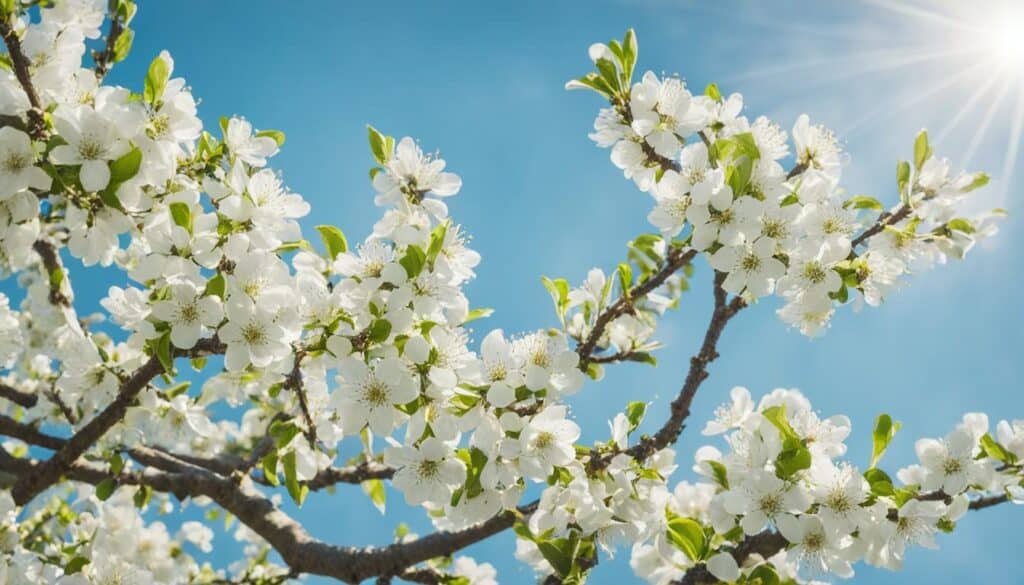
The Pear Blossom Tree, scientifically known as Pyrus communis, is an elegant flowering tree that belongs to the Rosaceae family. Native to Europe and western Asia, this tree is widely cultivated for its stunning blossoms and delicious fruits.
With its graceful branching structure, the Pear Blossom Tree adds a touch of sophistication to any garden. It can reach an impressive height of about 20-40 feet, creating a striking presence.
In early spring, the tree bursts into a profusion of small, white, or pink flowers that cover its branches, creating a picturesque scene. The delicate blooms not only enhance the tree’s beauty but also attract bees and other pollinators, ensuring a thriving ecosystem in the garden.
What makes the Pear Blossom Tree truly special is its dual role as both an ornamental and fruit-bearing tree. Alongside its captivating blossoms, it produces delectable fruits that can be enjoyed fresh or used in various culinary creations.
Whether you admire its ornamental elegance, indulge in its luscious fruits, or simply revel in the beauty of its blossoms, the Pear Blossom Tree is a remarkable addition to any landscape.
Wisteria Tree – Wisteria sinensis
The Wisteria Tree, scientifically known as Wisteria sinensis, is a stunningly beautiful deciduous flowering tree that is widely recognized for its cascading clusters of fragrant and vibrant blossoms. With its long, pendulous vines and abundant flowers, the Wisteria Tree creates a breathtaking display of color and beauty.
Native to China and often found near major temples and shrines, the Wisteria Tree holds symbolic significance as a representation of strength and good luck. Its stunning visual display and delightful fragrance make it a favorite choice for gardens and landscapes.
The image above showcases the stunning beauty of the Wisteria Tree with its cascading clusters of flowers in full bloom. (Image Credit: seowriting.ai)
Lilac Tree – Syringa vulgaris
The Lilac Tree, scientifically known as Syringa vulgaris, is a popular choice for home gardens due to its clusters of fragrant, lavender-colored flowers. This deciduous flowering tree belongs to the Oleaceae family and is native to eastern Europe. Lilac trees can be trained to grow into a large shrub or a small tree, adding a touch of elegance and fragrance to any landscape. Its stunning blooms typically appear in the spring, creating a delightful visual and olfactory experience for garden enthusiasts.
| Feature | Details |
|---|---|
| Blooms | Clusters of fragrant, lavender-colored flowers |
| Scientific Name | Syringa vulgaris |
| Family | Oleaceae |
| Height | Can be trained as a large shrub or small tree |
| Blooming Season | Spring |
Conclusion
In conclusion, the world is blessed with a variety of stunning fruit trees that can transform any garden into a paradise of blooming aesthetics and vibrant colors. From the delicate pink and white blossoms of the Cherry Blossom Tree to the cascading clusters of the Wisteria Tree, each tree brings its own unique beauty and charm. Whether for their visual appeal, cultural significance, or culinary value, these fruit trees captivate our hearts and souls with their enchanting blooms.
So, let’s celebrate the floral wonders of our planet and cherish these blossoming treasures that bring joy and beauty to our lives. Cast your vote and let me know which of these most beautiful fruit trees you find most captivating.
Thank you for joining me on this journey to explore the most beautiful fruit trees. Remember to appreciate the stunning fruit trees that grace our gardens and landscapes, and let their captivating presence fill your life with awe and inspiration.
FAQ
What is the scientific name of the Cherry Blossom Tree?
The scientific name of the Cherry Blossom Tree is Prunus serrulata.
Where is the Cherry Blossom Tree native to?
The Cherry Blossom Tree is native to Japan.
What is the symbolism of the Cherry Blossom Tree?
The Cherry Blossom Tree is a symbol of Japanese culture and history.
What is the scientific name of the Dogwood Tree?
The scientific name of the Dogwood Tree is Cornus florida.
Where is the Dogwood Tree native to?
The Dogwood Tree is native to the eastern United States.
What are the distinctive features of the Dogwood Tree?
The Dogwood Tree is admired for its showy flowers, attractive bark, and red foliage in the fall.
What is the scientific name of the Magnolia Tree?
The scientific name of the Magnolia Tree is Magnolia grandiflora.
Where is the Magnolia Tree native to?
The Magnolia Tree is native to the southeastern United States.
What are the notable features of the Magnolia Tree?
The Magnolia Tree is known for its large, fragrant flowers and glossy evergreen leaves.
What is the scientific name of the Apple Blossom Tree?
The scientific name of the Apple Blossom Tree is Malus pumila.
What are the visual and culinary attributes of the Apple Blossom Tree?
The Apple Blossom Tree is loved for its delicate, fragrant blossoms and bears fruit that is used in various culinary delights.
What is the scientific name of the Peach Blossom Tree?
The scientific name of the Peach Blossom Tree is Prunus persica.
Where does the Peach Blossom Tree originate from?
The Peach Blossom Tree originates from China.
What are the distinctive traits of the Peach Blossom Tree?
The Peach Blossom Tree showcases an abundance of stunning, delicate pink blooms, symbolizing the arrival of spring.
What is the scientific name of the Crabapple Tree?
The scientific name of the Crabapple Tree is Malus floribunda.
What are the ornamental features of the Crabapple Tree?
The Crabapple Tree is known for its abundant, vibrant blossoms and its ability to attract pollinators and wildlife.
What is the scientific name of the Pear Blossom Tree?
The scientific name of the Pear Blossom Tree is Pyrus communis.
Where does the Pear Blossom Tree originate from?
The Pear Blossom Tree is native to Europe and western Asia.
What are the characteristics of the Pear Blossom Tree?
The Pear Blossom Tree is an elegant flowering tree with small, white or pink blooms that attract bees and other pollinators.
What is the scientific name of the Wisteria Tree?
The scientific name of the Wisteria Tree is Wisteria sinensis.
Where is the Wisteria Tree native to?
The Wisteria Tree is native to China.
What are the stunning features of the Wisteria Tree?
The Wisteria Tree is renowned for its cascading clusters of fragrant and vibrant blossoms.
What is the scientific name of the Lilac Tree?
The scientific name of the Lilac Tree is Syringa vulgaris.
Where is the Lilac Tree native to?
The Lilac Tree is native to eastern Europe.
What makes the Lilac Tree a popular choice for home gardens?
The Lilac Tree is known for its clusters of fragrant, lavender-colored flowers, adding elegance and fragrance to any landscape.

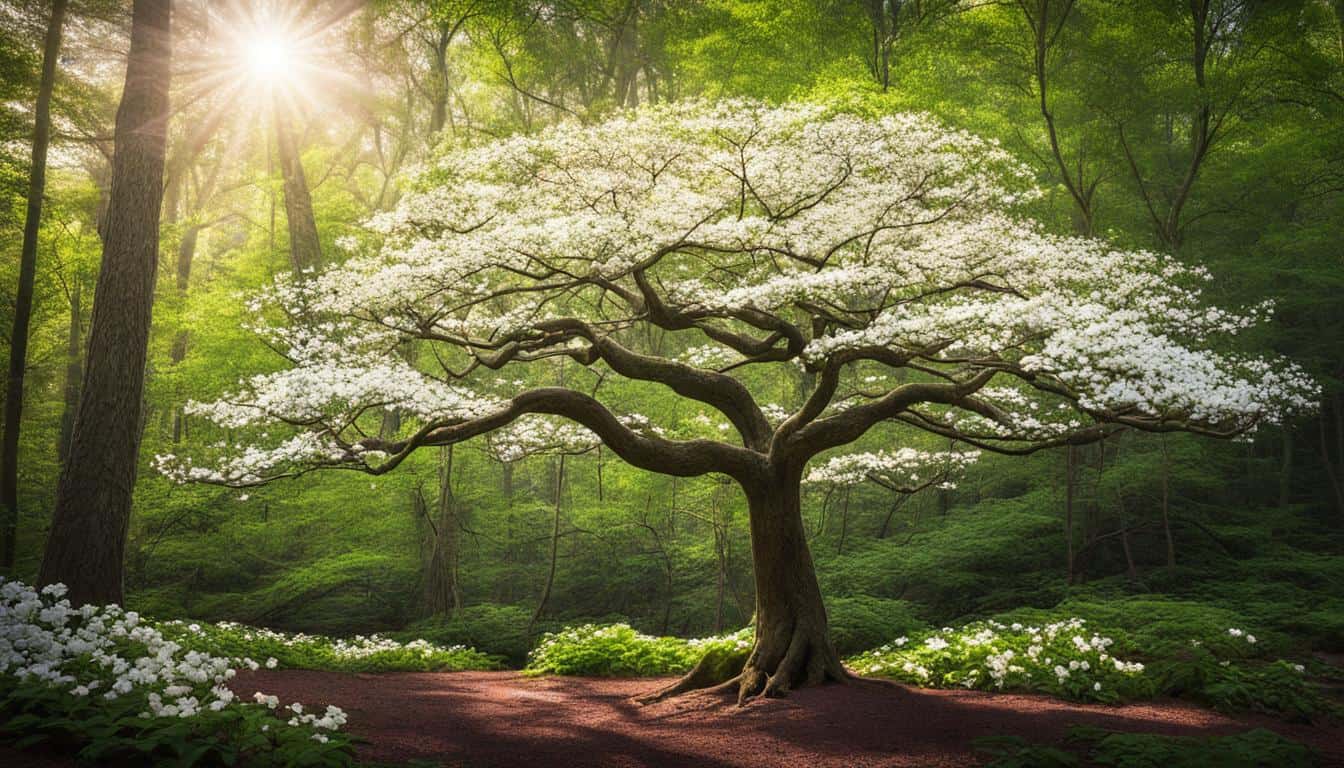



Leave a Reply